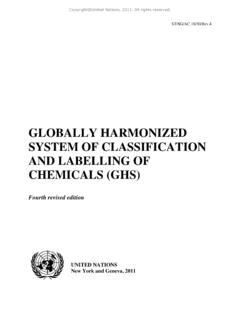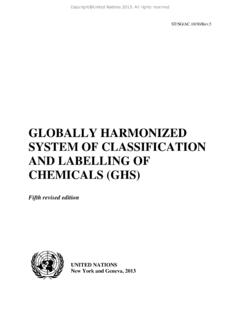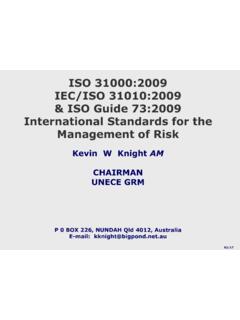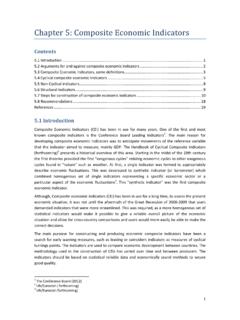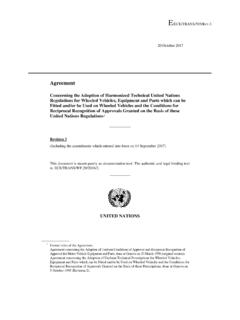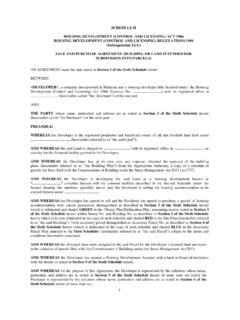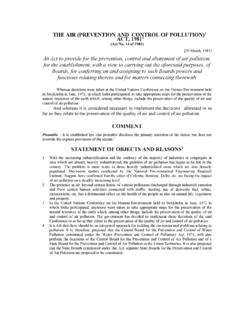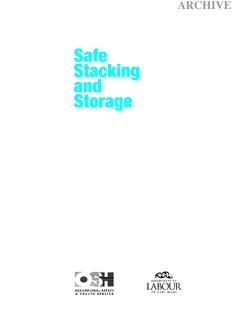Transcription of IMO/ILO/UNECE CTU Code
1 IMO/ILO/UNECE code of Practice for Packing of Cargo Transport Units (CTU code ) 2014 Table of contents Chapter 1. Introduction .. 2 Chapter 2. Definitions .. 5 Chapter 3. Key requirements .. 9 Chapter 4. Chains of responsibility and information ..11 Chapter 5. General transport conditions ..15 Chapter 6. CTU properties ..17 Chapter 7. CTU suitability ..22 Chapter 8. Arrival, checking and positioning of CTUs ..25 Chapter 9. Packing cargo into CTUs ..30 Chapter 10. Additional advice on the packing of dangerous goods ..32 Chapter 11. On completion of packing ..35 Chapter 12. Advice on receipt and unpacking of CTUs.
2 37 Chapter 13. Training in packing of CTUs ..39 Annexes Annex 1 Information flow Annex 2 Safe handling of CTUs Annex 3 Prevention of condensation damages Annex 4 Approval plates Annex 5 Receiving CTUs Annex 6 Minimizing the risk of recontamination Annex 7 Packing and securing cargo into CTUs Appendix 1 Packaging marks Appendix 2 Friction factors Appendix 3 Practical methods for the determination of the friction factor Appendix 4 Specific packing and securing calculations Appendix 5 Practical inclination test for determination of the efficiency of cargo securing arrangements Annex 8 Access to tank and bulk tops.
3 Working at height Annex 9 Fumigation Annex 10 Topics for consideration in a training programme 1 Preamble The use of freight containers, swap bodies, vehicles or other cargo transport units substantially reduces the physical hazards to which cargoes are exposed. However, improper or careless packing of cargoes into/onto such units, or lack of proper blocking, bracing and lashing, may be the cause of personnel injury when they are handled or transported. In addition, serious and costly damage may occur to the cargo or to the equipment. The types of cargoes carried in freight containers has expanded over many years and innovations such as use of flexitanks and developments allow heavy, bulky items which were traditionally loaded directly into the ships hold ( stone, steel, wastes and project cargoes), to be carried in cargo transport units.
4 The person who packs and secures cargo into/onto the cargo transport unit (CTU) may be the last person to look inside the unit until it is opened at its final destination. Consequently, a great many people in the transport chain will rely on the skill of such persons, including: road vehicle drivers and other road users when the unit is transported by road; rail workers, and others, when the unit is transported by rail; crew members of inland waterway vessels when the unit is transported on inland waterways; handling staff at terminals when the unit is transferred from one transport mode to another; dock workers when the unit is loaded or unloaded; crew members of a seagoing ship during the transport operation.
5 Those who have a statutory duty to inspect cargoes; and those who unpack the unit. All persons, such as the above, passengers and the public, may be at risk from a poorly packed freight container, swap body or vehicle. 2 Chapter 1. Introduction Scope The aim of this IMO/ILO/UNECE code of Practice for Packing of Cargo Transport Units (CTU code ) is to give advice on the safe packing of cargo transport units (CTUs) to those responsible for the packing and securing of the cargo and by those whose task it is to train people to pack such units.
6 The aim is also to outline theoretical details for packing and securing as well as to give practical measures to ensure the safe packing of cargo onto or into CTUs. In addition to advice to the packer, the CTU code also provides information and advice for all parties in the supply chain up to and including those involved in unpacking the CTU. The CTU code is not intended to conflict with, or to replace or supersede, any existing national or international regulations which may refer to the packing and securing of cargo in CTUs, in particular existing regulations which apply to one mode of transport only, for transport of cargo in railway wagons by rail only.
7 Safety Improperly packed and secured cargo, the use of unsuitable CTUs and the overloading of CTUs may endanger persons during handling and transport operations. Improper declaration of the cargo may also cause dangerous situations. The misdeclaration of the CTU s gross mass may result in the overloading of a road vehicle or a rail wagon or in the allocation of an unsuitable stowage position on board a ship thus compromising the safety of the ship. Insufficient control of humidity may cause severe damages to and collapse of the cargo and cause also the loss of the stability of the CTU.
8 Security It is important that all personnel involved in the packing, security sealing, handling, transport and processing of cargo are made aware of the need for vigilance and the diligent application of practical procedures to enhance security, in accordance with national legislation and international agreements. Guidance on the security aspects of the movement of CTUs intended for carriage by sea may be found in a variety of documents including the International Convention for the Safety of Life at Sea (SOLAS), 1974, as amended; the International Ship and Port Facility Security (ISPS) code ; the ILO/IMO code of Practice on Security in Ports.
9 And the Standards and the Publicly Available Specifications developed or being developed by the International Organization for Standardization (ISO) to address cargo security management and other aspects of supply chain security. Furthermore, the World Customs Organization (WCO) has developed a SAFE Framework of standards to secure and facilitate global trade. How to use the CTU code This code comprises 13 chapters. Most of them refer to one or more annexes which is highlighted in the text where applicable. Further practical guidance and background information are available as informative material1, which does not constitute part of this code .
10 Table 1 at the end of this chapter provides a summary of contents. More information on the consequences of improper packing procedures is provided in informative material IM1. Following the introduction in chapter 1, chapter 2 lists definitions of terms which are used throughout the code . Chapter 3 provides an overview of basic safety issues related to the packing of CTUs, briefly described as dos and don ts . Detailed information on how to comply with these dos and how to avoid the don ts are contained in the following chapters and in the related annexes.




